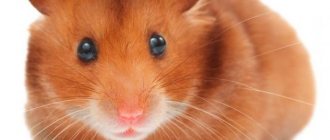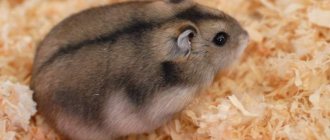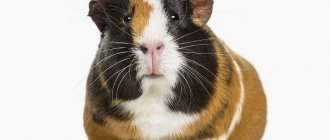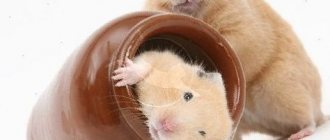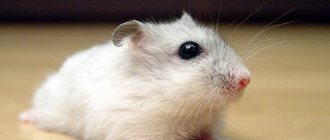Hamsters are playful, interesting animals. They come in different breeds. You can buy a Syrian hamster in Russia at a price from 50 to 1800 rubles .
Syrian hamsters belong to the class of mammals. They have medium and large sizes. The body length of adult individuals can reach 13-19 cm . Females are always larger than males. Life expectancy at home is 1-3 years . These animals feed on dry food.
Syrian hamsters have short legs, a stocky body, rounded ears, and a small rounded muzzle. The first breeders of this breed were the British. Thanks to their work, Syrian domestic rodents of different colors appeared. Under natural conditions, such hamsters live in Turkey, Asia, and Iran. They are found in steppes, meadows and grain fields.
You may need to buy a Syrian hamster for the following purposes:
- As a pet.
- For breeding and selling offspring.
- As a gift to family and friends.
Djungarian hamster
Djungarian or Siberian hamsters belong to the hamster . Individuals of this breed are small, with thick fur, a pointed muzzle and black bulging eyes. A distinctive feature of dzhungariks is their color. These furry rodents have a dark stripe on their back. The main color can be different (usually gray).
Siberian hamsters are common in Mongolia, Kazakhstan, western Siberia and northwestern China. Rodents of the family Macnopods are small in size, grow up to 5-10 cm and weigh about 40-50 grams . Djungarians are very sociable and funny, well suited for keeping at home, however, it is difficult to accustom them to certain actions.
Conditions of detention and care
Campbell hamsters are unpretentious. They do not require a special microclimate. The pet will not take up much space. At the same time, it is important to provide the animal with high-quality nutrition and properly organize the space in its cage. This will help maintain the rodent's physical activity and help maintain its health.
Hamster lifespan
How long Campbell hamsters live depends on the quality of care and maintenance. If the animal receives the optimal amount of nutrients and has enough space for physical activity, it will delight its owners for 2-3 years. In rare cases, the life expectancy of a pet reaches 5 years.
Diseases of the breed
Hamsters of this breed are distinguished by good health. Older individuals get sick more often. They often suffer from infectious and parasitic diseases. Some of them can be transmitted to humans. In addition, these hamsters have a predisposition to some non-infectious pathologies.
The following symptoms indicate the presence of health problems in a rodent:
- increased lacrimation;
- bowel dysfunction;
- purulent discharge from the eyes;
- profuse lacrimation;
- decreased appetite;
- convulsions;
- lack of coordination;
- peeling and wounds on the skin;
- dullness of wool, tangles;
- depressed state;
- neoplasms on the body;
- wheezing;
- nasal discharge;
- decreased activity.
Most often, hamsters suffer from respiratory diseases caused by influenza viruses, herpes, etc. Leaving a cage with a rodent in a cold room or in a draft can contribute to the appearance of such a problem.
Respiratory infections are more common in animals with reduced immunity.
When a respiratory disease develops, the rodent begins to intensively rub its face with its paws, sneezes and often snorts. The animal's breathing is often accompanied by whistling. Improving conditions within 2 days leads to recovery.
Infection of a hamster's lungs with bacteria causes pneumonia. This is a dangerous disease, most often caused by diplococci, staphylococci, pneumococci, etc. A purulent secretion is released from the animal's nose and mouth. The rodent's body temperature rises sharply. Within a few days the animal dies.
Domestic rodents often suffer from helminthic infestation. More often, hamsters become infected with intestinal parasites, incl. tapeworms and roundworms.
The disease negatively affects the growth and development of the animal, and often causes diarrhea. The source of parasites can be contaminated food, bedding or water.
Another common pathology of hamsters is demodicosis. It is caused by microscopic mites that infect the upper layers of the epidermis, causing hair loss.
Lymphocytic choriomeningitis is relatively rarely detected in rodents. It is caused by a virus that can be transmitted to humans. It causes severe disturbances in brain function, accompanied by convulsions, depression of the respiratory system, etc. In most cases, the disease leads to the death of the animal.
Eye diseases in hamsters.
Feeding ration
It is recommended to give an adult hamster up to 50 g of food per day. You should not feed the animal too much, because... this will lead to obesity. In addition, the rodent will hide some of the excess food.
Every day the hamster should be given a grain mixture, which should include:
- oats;
- corn;
- wheat;
- nuts;
- sunflower and pumpkin seeds.
Juicy foods recommended for animals include:
- zucchini;
- pumpkin;
- beets;
- cucumbers;
- leafy greens;
- cabbage;
- apples;
- bananas;
- pears;
- raspberries;
- grape;
- watermelon, etc.
Several times a week you should give your rodent boiled fish or meat, as well as live insects.
Pamper your pet with treats.
Home improvement
A hamster needs a cage with a size of at least 40x60 cm. The distance between the rods should be no more than 0.5 cm. It is better to choose cages equipped with a plastic tray.
The animal's house should be placed in a place where direct sunlight does not fall. In addition, the rodent should not be exposed to drafts.
The cage should contain:
- grass house;
- labyrinth;
- stairs;
- running wheel;
- mineral stone for grinding teeth;
- feeders for different types of food;
- drinking bowls
Soft hay and wood shavings can be used as filler.
The cage should contain everything necessary for a comfortable life for a hamster.
How many individuals can live in one cell?
Campbell hamsters do not like company, so it is better to house them alone. In rare cases, keeping rodents in pairs is also acceptable.
Cage cleaning and hygiene
Hamsters are quite clean and take good care of their fur. If the animals do not have health problems, their ears and eyes remain clean. They defecate mainly in one place. It is necessary to change the bedding in the cage once a week.
Hamsters take care of their own fur.
Walking outside the cage
Walking outside the cage is only allowed under supervision. The hamster may run under furniture or eat an inedible object. There is no need to place the rodent on a table or sofa. Falling from a height can cause injury.
Reproduction of hamsters
Hamsters become sexually mature at 3-4 months. The most favorable period for reproduction is from March to September. During the season, a female can bear 4 offspring.
A few days before the pair is created, cages of opposite-sex rodents are placed side by side. This will help the animals establish contact. The future parents are then seated together. After conception, the pregnant female is removed. The offspring appears in 15-21 days.
During this period, the female arranges the nest, covering the bottom of the house with soft grass, etc. For 10 days you should not try to handle the young animals, because... this can provoke aggression of the female towards the cubs.
Dispersal of offspring
10 days after birth, the young animals grow fur and their eyes open. At 12 days of age, the cubs must be separated from the female.
Taming the Campbell's Hamster
Only a young animal can be tamed. You need to have contact with the hamster every day, your hands should be clean. It is not recommended to make sudden movements or make loud noises.
When talking to a rodent, you should speak quietly so that it gets used to the voice of its owners. The animal is first taken so that all its paws stand on the person’s palm.
At the same time, you can stroke your pet's head and back with light movements. You should not grab the head or try to stroke the animal's paws, as this can provoke aggressive behavior in the rodent.
Take the hamster into your palm, gently stroking it and talking affectionately.
What determines the price of Djungarian hamsters?
The cost of hamsters depends mainly on where they are sold. In the Russian Federation, fluffy dwarfs can be bought by hand, at the market, in a pet store or in a nursery. The cheapest option is to buy at the market, where hamsters are sold for 50-200 rubles . However, in this case, you need to pay attention to the pet’s health status, as well as its age. If an animal is offered that is 1-2 years old, it is better to refuse immediately, since the life expectancy of the dzhungarika is very short - only 2-3 years.
Dzhungars sold by breeders and individuals cost approximately 100-200 rubles For this price you can buy a tamed and well-groomed hamster. Private owners, as well as some pet stores, sometimes give away cubs for free. The reason for this is most often that a lot of babies are born, and it becomes difficult to support them. But it must be remembered that Dzungars are ready for independent life separately from their mother only from the age of one month.
In pet stores and nurseries, dzhungariki can be sold for 300-500 , and sometimes even 1000 rubles . The reasons for such a high price include the presence of documents on the rodents being sold. Moscow pet stores are more expensive.
Purchasing a furry animal entails other expenses. You need to buy your hamster a cage, litter and food for the first time. The total cost of these expenses will be about 2000-7000 rubles (depending on the selected cell). Keeping your pet is much cheaper.
Factors influencing price
The cost of a Syrian hamster is influenced by many factors. Therefore, its price varies widely. When compiling a price list, sellers take into account the following points:
- Age.
- Purebred breed.
- Availability of a veterinary passport and other documents.
- Health status.
- Character.
- Gender.
- Delivery required.
- Place of purchase.
Females are more expensive than males . You will have to pay extra for the delivery of the animal. Purebred individuals are valued higher than crosses of different breeds. Tame, kind rodents have a higher price than aggressive ones that do not make contact with humans. The more famous the seller, the higher his price will be.
Types of Dzungars and their prices
Unlike other breeds of hamsters, Djungarian hamsters are not divided into short-haired and long-haired . Their fur is equally thick and the hairs are of medium length. Among Djungarian hamsters, there are decorative varieties obtained through selection that differ in color. There are red, sapphire and pearl-white individuals of decorative dzhungarikas. Specially bred hamsters are more expensive than regular ones, sometimes twice their price. For them the buyer will have to pay about 500-1000 rubles .
Decorative hamsters are more demanding in terms of living conditions, are susceptible to stress and are less resistant to disease.
Examples of the cost of Siberian hamsters
The Dzungarian breed is relatively small, so representatives of this species are a little more expensive. If you buy a Djungarian hamster at a pet store, you can also purchase a cage at the same time. An ordinary gray jungar, 1 month old, including a cage, will cost about 600-700 rubles . But this price is only relevant if the cage is for transportation. If you buy a decorative cage with a hamster, the purchase will cost 3,000-10,000 rubles . If you buy a decorative animal without a house, you will need to pay about 500-1000 rubles, the cost together with the cage will be approximately 4000-11000 .
The price of an ordinary hamster along with a regular cage and food for a month will be approximately 1000 rubles . If you add filler to the above, the purchase will cost 1000-1200 rubles . You can also buy a wheel, paying 200-300 rubles more.
If you buy a walking ball for your fluffy, the costs will increase by 500 rubles. As a result, an ordinary hamster in an ordinary cage with all additional expenses will cost 1800-2000 rubles, and a decorative animal in a metal cage will cost 1800-2000 rubles. 5000-12000.
Varieties
You can choose a hamster by gender:
- Female.
- Male.
Depending on age, you can buy:
- Small.
- An adult hamster.
Depending on the availability of documents, you can purchase a rodent:
- With veterinary passport.
- Without a veterinary passport.
Hamsters with documents are more expensive.
Depending on the color there are hamsters:
- Golden.
- Cream.
- Black.
- Smoky.
- Beige.
- Yellow-brown.
- White.
- Lilac.
- Dark gray.
- Brown.
- Silvery.
- Chocolate.
- Satin.
- Honey.
- Gray.
There are monochromatic and multi-colored individuals: for example, white-cream or black-brown. Multi-colored colors come in the following types:
- With a belt.
- Spotted with a belt.
- Tortoiseshell with white.
- Roan.
- Tortoiseshell.
Depending on the length of the coat there are individuals:
- Long-haired.
- Short-haired.
- Hairless, bald.
You can buy a rodent in this way:
- At the pet market.
- From the breeder.
- At the pet store.
- In the nursery.
- At the animal shelter.
- In the online store.
- According to a private advertisement on the Internet or in a newspaper.
The most expensive purchase will be at a pet store. The cheapest way to buy a rodent is through a private advertisement.


